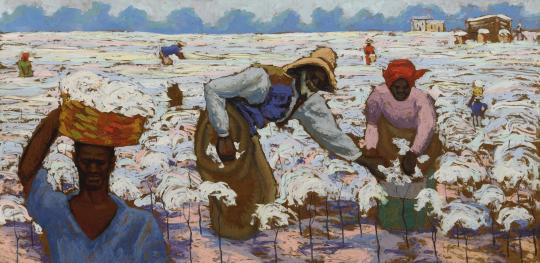#hale woodruff
Photo
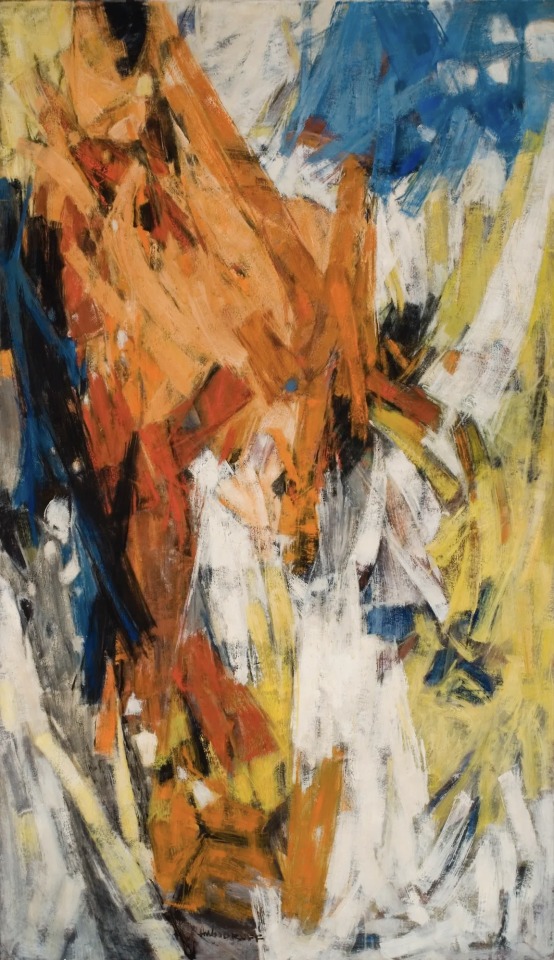
Hale Woodruff (American, 1900-1980), Blue Intrusion, 1958. Oil on canvas
130 notes
·
View notes
Text

Hale Woodruff - The Mutiny on the Amistad
Click Links at bottom of pictures to EMBIGGEN

Hale Woodruff - In this 1939 mural, Woodruff depicts the trial of the Africans aboard the Amistad.
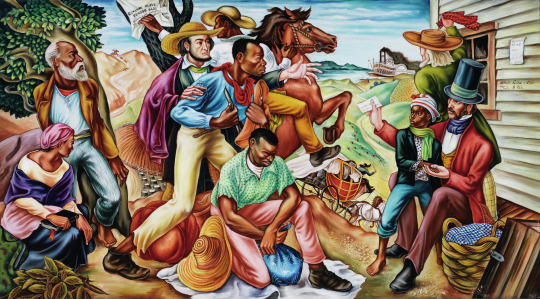
Hale Woodruff - The Underground Railroad

Hale Woodruff - The Repatriation of the Freed Captives

Hale Woodruff - Opening Day at Talladega College

With Powerful Murals, Hale Woodruff Paved The Way For African-American Artists
Woodruff's figurative style of the 1930s was bold and muscular. Southern lynchings of blacks stirred his conscience deeply, and inspired him to design a series of block prints that were as impressive as his oils and watercolors. His best-known and most widely acclaimed works at this time were the Amistad murals he painted between 1939 and 1940 in the Slavery Library at Talladega College in Alabama. These murals were commissioned in celebration of the one-hundredth anniversary of the mutiny by African slaves aboard the slave ship Amistad in 1849, their subsequent trial in New Haven, Connecticut, and return to West Africa following acquittal.

49 notes
·
View notes
Text

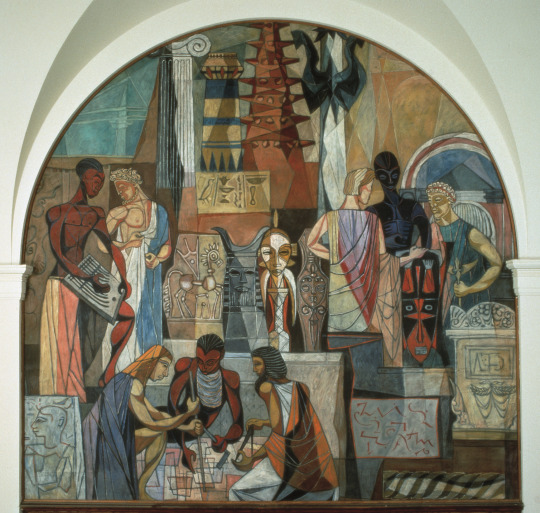
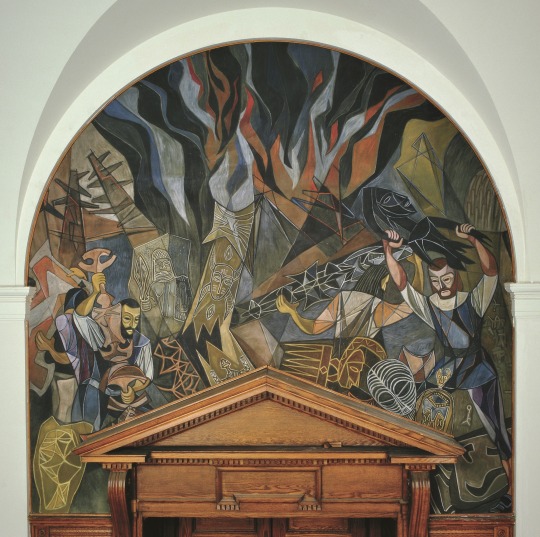
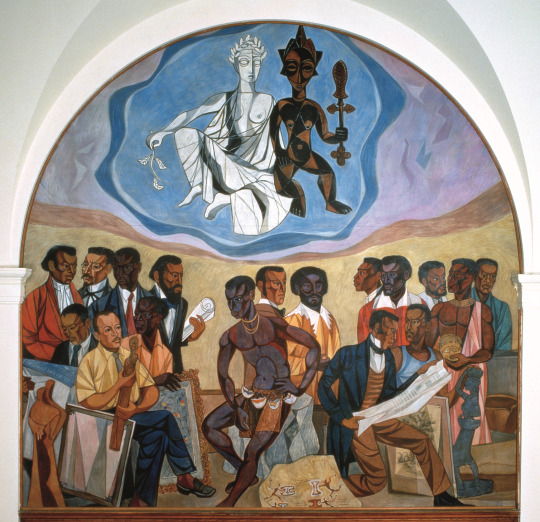

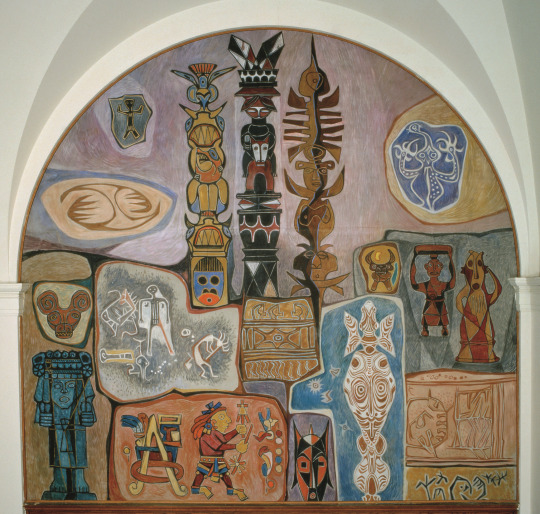
The Art of the Negro Murals
Housed in the atrium of Trevor Arnett Hall, the Art of the Negro mural series was painted by Hale Aspacio Woodruff (1900-1980) and consists of six, 12 x 12 foot oil on canvas panels. Woodruff, founder of the Atlanta University art department and permanent collection, painted the murals between 1950 and 1951. Woodruff aspired to providing the university community with a global narrative on the cultural history of Africans in the Americas. Referring to his rationale for painting the murals, Woodruff stated:
"It portrays what I call the Art of the Negro. This has to do with a kind of interpretive treatment of African art. . . . I look at the African artist, certainly, as one of my ancestors regardless of how we feel about each other today. I’ve always had a high regard and respect for the African artist and his art. So this mural, . . .is for me, a kind of token of my esteem for African art. One of the motivations again for doing these would be these murals would deal with a subject about which little was known—art and also among Negroes, there was little concern about our ancestry. Then I took the idea that art, being a little known subject, would attract the curiosity and attention of young people, as well as older people, toward further study and in that way the murals would have educational value. I thought also that the unusual subject matter would be timeless in a sense that the arts are always timeless."
Although Woodruff proposed to paint the murals after completing the Amistad mural series at Talledega College in 1939 and conferring with the Mexican muralist Diego Rivera, Atlanta University did not grant him the opportunity until 1950. By this time he had relocated to New York City and joined the faculty at New York University. Hence, the murals were painted in his New York studio. Woodruff declared them to be the best of all his murals.
Courtesy of Clark Atlanta University Art Museum
#social realism#african american art#hale woodruff#murals#early Indiana art#Indianapolis#Herron school of Art
38 notes
·
View notes
Photo
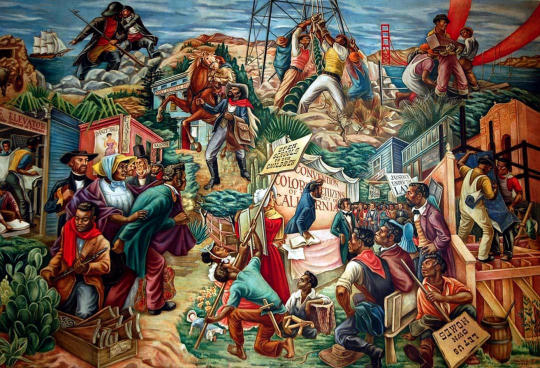
MWW Artwork of the Day (2/10/23)
Hale Woodruff (African-American, 1900-1980)
The Negro in California History: Settlement and Development (1949)
Mural
Golden State Mutual Life Building, Los Angeles CA
In 1949, Golden State Mutual Life commissioned two major Harlem Renaissance painters, Charles Alston and Hale Woodruff, to paint a pair of murals for their Paul Williams-designed building at Western and Adams. They were titled "The Negro in California History," with Alston doing "Colonization and Exploitation" and Woodruff's "Settlement and Development" (reproduced here). Born in Cairo, Illinois and educated at Harvard, Woodruff was an African-American artist best known for his murals, paintings, and prints.
More of this artist's work appears in this MWW exhibit/gallery:
https://www.facebook.com/media/set/?set=a.343798162392226&type=3
10 notes
·
View notes
Photo
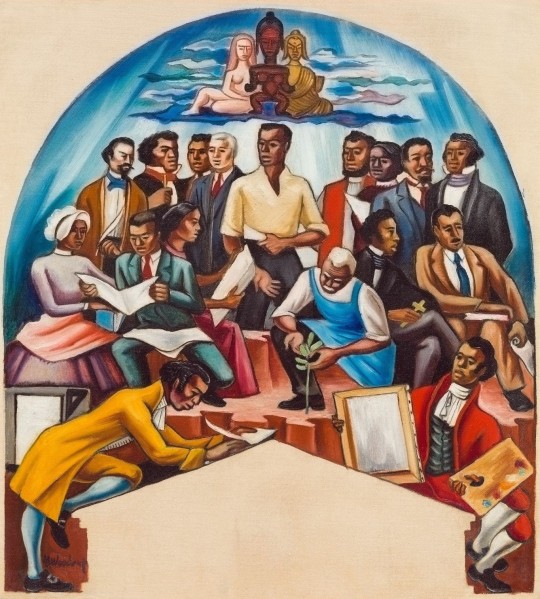
Hale Woodruff (1900-1980) — The Art of the Negro: Artists, Study [oil on canvas, 1951]
47 notes
·
View notes
Photo
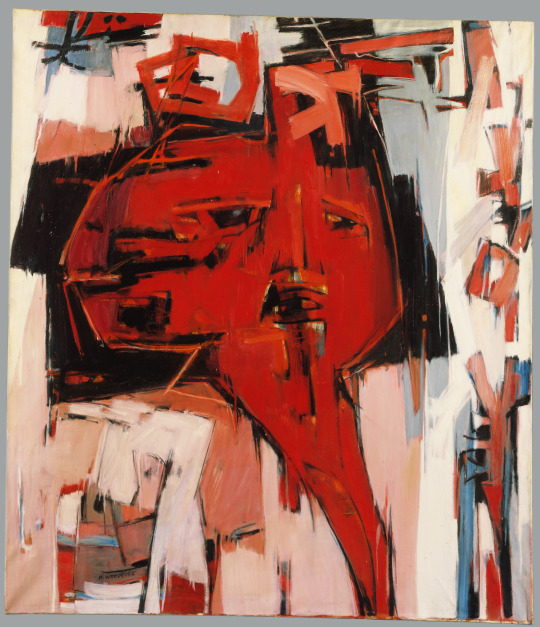
Ancestral Memory
Hale Woodruff (American; 1900–1980)
mid-20th century
Oil on canvas
Detroit Institute of Arts, Detroit, Michigan
#Hale Woodruff#Woodruff#ancestors#memory#1950s#1950s art#1950s painting#1950s American art#mid-century modern#African American art#African American artists#African American painters#African American paintings#American art#American artists#American paintings#abstract art#abstraction
32 notes
·
View notes
Photo
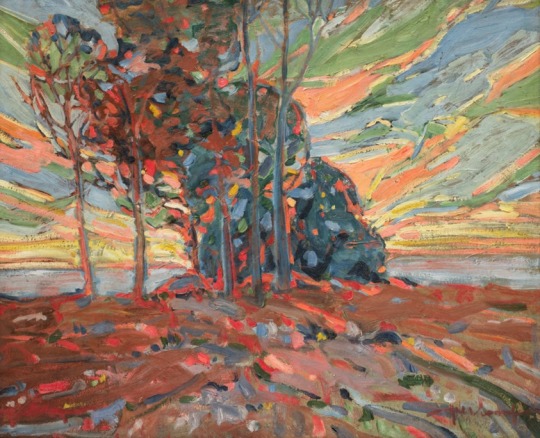
Twilight (c. 1926)
Hale Woodruff, American, 1900–1980
Oil on pressed paperboard
4 notes
·
View notes
Text
A Youth -- Hale Woodruff
A Youth, 1934 by Hale Woodruff (1900-1980)
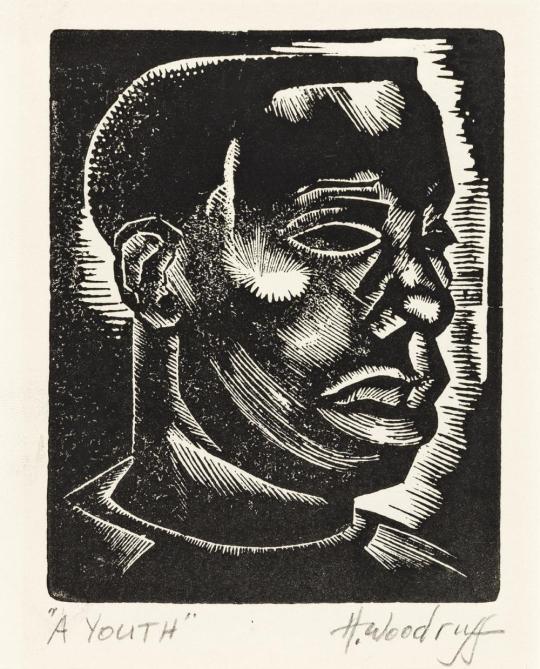
View On WordPress
0 notes
Text

Hale Aspacio Woodruff - Untitled (Abstract)
0 notes
Photo

Hale Woodruff - Medieval Chartres, 1928.
60 notes
·
View notes
Text

Hale Aspacio Woodruff, The Art of the Negro Murals
Clark Atlanta University Art Museum
source: pwlanier
9 notes
·
View notes
Text

Born in 1937 in Georgia, Emma Amos took an interest in art while she was a child. She made paper dolls and copied the figures from magazines.
At age eleven she took classes at Morris Brown School. She improved her draftsmanship and was exposed to the art of other Black American students.
While she was still in high school, she was already submitting her work to art shows at Atlanta University.
It was clear for the very beginning, Emma was going places.
Emma studied art at the Central School of At in London after graduatiing for Antioch College in Ohio. She would move to New York looking for a more vibrant art scene that she couldn't find in Georgia upon returning to the US.
She would be blindsided by the racism and sexism and even, ageism she was met with, perhaps assuming the more metropolitan state would be more progressive.
She was too young for galleries to bother with her and she had trouble finding positions available to teach.
She did eventually find work, as an assistant, at the Dalton School.
This did end up fortuitous as she met other artists that introduced her to the art scenes in New York and East Hampton.
She still found struggles. She was a woman in an art world that prioritized the work of men. And she was a black woman, and like many black artists, struggled to find dealers and curators that wanted to work with her.
Emma would not be deterred.
She joined Letterio Calapai's print making studios and Robert Blackburn's Printmaking Workshop. She earned her Masters of Art from New York University in 1966 and became reacquainted with artist Hale Aspacio Woodruff who was teaching there.
She met with Woodruff for feedback and criticism of her work and he introduced her to Spiral Arts Alliance. A collective of African-American Artists. Not just art, this group discussed philosophy, and culture about the meaning of blackness within the African diaspora. A frame work for critique and cultivating "Black Consciousness" and a common racial identity.
She would be allowed to join, as the first female member of the group.
At this time, she was working full time as a designer and studying full time as well. It left her only time to paint on the weekends.
In 1965 Spiral rented space for the first and only Exhibition. Emma would exhibit an etching called Without a Feather Boa, that sadly, is now lost.
Described as a self portrait, a nude bust, of Emma looking dispassionately at the viewer from behind sunglasses.
Before this, Emma has been reticent to participate in the idea of Black Art and galleries and shows that only showed the work of black Americans. Like so many artists, she likely though of herself as an artist first, but came to understand the harsh reality was that there were not a lot of options for black artists. These Black Art shows and galleries were the only way to get your foot in the door.
Despite this early resistance, she embraced sex and race in her art, toeing the line of politics but never allowing her work to be drowned in controversy. There were often depictions of the confederate flag, the American flag, traditional African patterns, including her own weavings as she was a well accomplished craftsman as well as a painter.
Emma became a professor in 1980, and later chair of the Visual Arts Department at the Mason Gross School of Art at Rutgers University, and she would teach there for close to thirty years.
During her time here she would join the Heresies Collective. A feminist group founded in 1976 in New York by feminist political artists.
She says of the group:
"And that’s what Heresies became for me. All of my disdain for white feminists disappeared, because we were all in the same boat. We just came to the boat from different spaces."
She was also a member of the feminist group Guerilla Girls under the pseudonym Zora Neale Hurston.
In these groups, and others she took part in, she discussed the sex revolution of the 60s and 70's the failures of white feminism, and the privilege of white Americans in the arts and in life.
She was keenly aware of artists that existed within the margins of society and how difficult it is for those people to continue activities in comparison the white hegemonic art circles.
In 2008, Emma retired from teaching, but she never stopped being a teacher, supporting her students even after, going to their exhibitions and continuing to inspire and be inspired.
In 2020, Emma died from complications of Alzheimer's Disease. She was 83.
Her work is viewable in many, many galleries and museums and we've only just scratched the surface of this woman's art, passions, and intriguing life. If you'd like to see more of Emma's work and learn more about her:
Museum of Modern Art - Emma Amos - Works
Philadelphia Museum of Art - Emma Amos: Color Odyssey
Virtual Discussion: Emma Amos: Color Odyssey
NYT Emma Amos, Painter who challenged Racism and Sexism, Dies at 83
DVD/VHS for purchase Emma Amos - Actions Lines
Ryan Lee Gallery - Emma Amos
Emma Amos Website
#Emma Amos#Black History Month#Black Artist#Black Art History#Black Feminist Artist#Art History#Painter#Printmaker#Weaver#Artisan#Black Craftsman
13 notes
·
View notes
Text

Possibly Hale Woodruff
American, active 20th century
Cheese Factory, 1930s
Oil on canvas
Milwaukee Art Museum
11 notes
·
View notes
